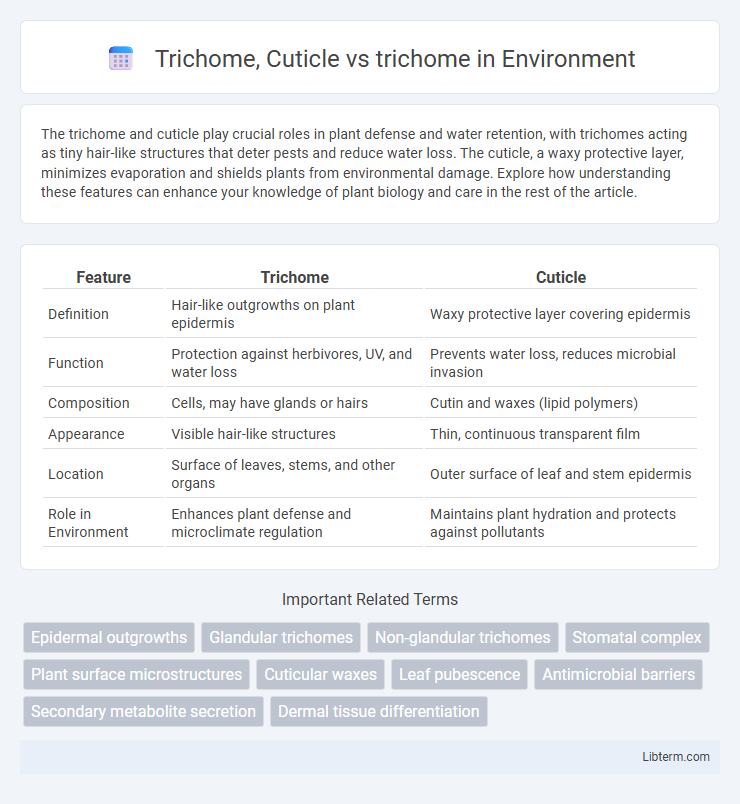The trichome and cuticle play crucial roles in plant defense and water retention, with trichomes acting as tiny hair-like structures that deter pests and reduce water loss. The cuticle, a waxy protective layer, minimizes evaporation and shields plants from environmental damage. Explore how understanding these features can enhance your knowledge of plant biology and care in the rest of the article.
Table of Comparison
| Feature | Trichome | Cuticle |
|---|---|---|
| Definition | Hair-like outgrowths on plant epidermis | Waxy protective layer covering epidermis |
| Function | Protection against herbivores, UV, and water loss | Prevents water loss, reduces microbial invasion |
| Composition | Cells, may have glands or hairs | Cutin and waxes (lipid polymers) |
| Appearance | Visible hair-like structures | Thin, continuous transparent film |
| Location | Surface of leaves, stems, and other organs | Outer surface of leaf and stem epidermis |
| Role in Environment | Enhances plant defense and microclimate regulation | Maintains plant hydration and protects against pollutants |
Introduction to Trichomes and Cuticles
Trichomes are microscopic hair-like structures on plant surfaces that play a vital role in defense against herbivores, UV radiation, and water loss. The cuticle, a waxy protective layer covering the epidermis, functions primarily to minimize water evaporation and protect against pathogens. While trichomes provide physical and chemical protection, the cuticle forms a continuous barrier essential for maintaining plant hydration and overall health.
What Are Trichomes?
Trichomes are tiny hair-like structures found on the surface of plants, primarily serving as a defense mechanism against herbivores and environmental stress. Unlike the cuticle, which is a waxy protective layer covering the epidermis to prevent water loss, trichomes can secrete substances such as oils, resins, or toxins to deter pests and reduce transpiration. These specialized epidermal outgrowths play a crucial role in plant protection, temperature regulation, and ultraviolet light absorption.
Structure and Types of Trichomes
Trichomes are hair-like epidermal structures found on plant surfaces, differing significantly from the cuticle, which is a waxy protective layer covering the epidermis. Trichomes vary in structure, including glandular types that secrete substances and non-glandular types that provide physical defense or reduce water loss. These diverse forms, such as simple unicellular hairs, branched, and multicellular trichomes, play key roles in plant protection, temperature regulation, and interaction with the environment.
Functions of Trichomes in Plants
Trichomes are specialized epidermal structures on plants that serve multiple protective functions, including defense against herbivores through physical barriers and chemical secretion, as well as reducing water loss by limiting transpiration. Unlike the cuticle, a waxy outer layer that primarily acts as a waterproof barrier, trichomes provide mechanical protection and can reflect excess light to prevent damage from UV radiation. Trichomes also play a role in temperature regulation and can trap moisture, enhancing the plant's ability to survive in harsh environmental conditions.
What Is the Plant Cuticle?
The plant cuticle is a waxy, hydrophobic layer covering the epidermis of leaves, stems, and fruits, serving as a primary barrier against water loss and environmental stress. Unlike trichomes, which are hair-like outgrowths that can provide defense against herbivores and reduce transpiration, the cuticle functions mainly as a protective membrane regulating gas exchange and preventing pathogen entry. This lipid-rich layer is composed primarily of cutin and embedded waxes, crucial for maintaining plant hydration and structural integrity.
Cuticle Structure and Role
The cuticle is a protective, waxy layer covering the epidermis of plant leaves and stems, primarily composed of cutin and waxes that prevent water loss and shield against environmental damage. Unlike trichomes, which are hair-like appendages serving roles in defense, secretion, and light reflection, the cuticle functions as a continuous barrier regulating gas exchange and minimizing pathogen entry. Its structural integrity is vital for maintaining plant hydration and overall health, making the cuticle essential in plant adaptation to terrestrial habitats.
Key Differences: Cuticle vs. Trichome
Trichomes are hair-like structures on plant surfaces that serve various functions including protection against herbivores and reduction of water loss, whereas the cuticle is a waxy, protective layer covering the epidermis. Unlike the cuticle, which is a continuous hydrophobic barrier, trichomes are discrete appendages that can be glandular or non-glandular. Key differences between cuticle and trichomes include structure (continuous film versus individual hairs), function (barrier versus specialized defense or secretion), and composition (primarily cutin and waxes for cuticle, versus cellular tissues for trichomes).
Comparative Functions of Cuticle and Trichome
The cuticle primarily serves as a protective barrier against water loss and environmental damage, composed of a waxy layer that minimizes transpiration. Trichomes, on the other hand, are hair-like structures that provide defense against herbivores and reduce heat by reflecting sunlight, often secreting substances for additional protection. Both structures enhance plant survival but differ in their specific roles: the cuticle focuses on moisture retention and physical shielding, while trichomes contribute to defense and microenvironment regulation.
Importance in Plant Adaptation and Protection
Trichomes, tiny hair-like structures on plant surfaces, serve critical roles in adaptation and protection by reducing water loss, reflecting excessive sunlight, and deterring herbivores through physical barriers or chemical secretions. The cuticle, a waxy layer covering the epidermis, complements trichomes by providing a waterproof barrier that minimizes dehydration and guards against pathogen invasion. Together, trichomes and the cuticle enhance plant resilience in harsh environments, ensuring survival by optimizing water retention and defense mechanisms.
Conclusion: Trichomes and Cuticle Significance
Trichomes and the cuticle serve critical roles in plant protection, with trichomes acting as specialized hair-like structures that deter herbivores and reduce water loss, while the waxy cuticle provides a waterproof barrier to minimize dehydration and pathogen entry. Both structures contribute to optimal plant survival by regulating microclimate and defense mechanisms on the epidermal surface. Understanding their complementary functions enhances strategies in agriculture to improve crop resilience and stress tolerance.
Trichome, Cuticle Infographic

 libterm.com
libterm.com